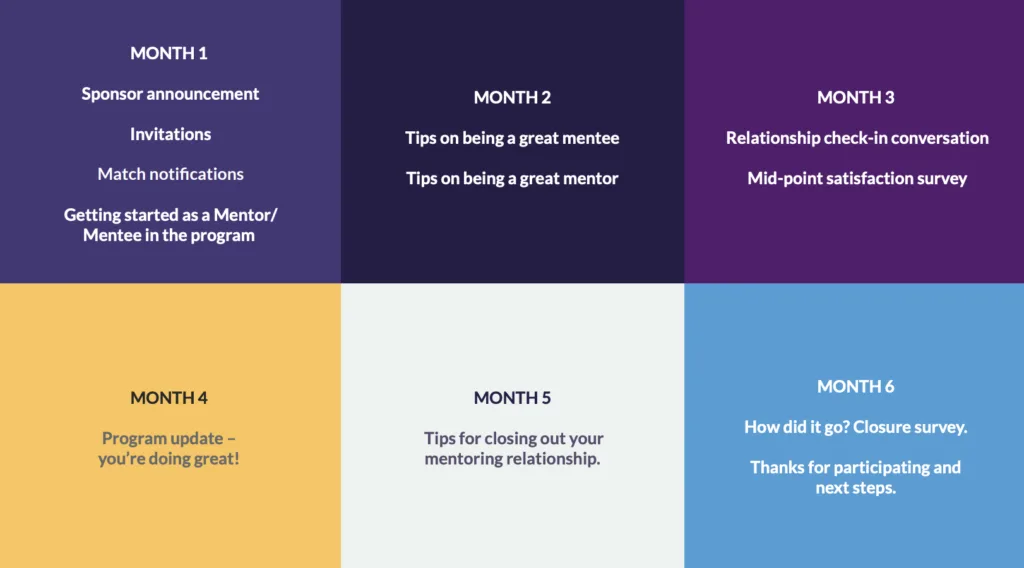OK, let’s be honest. It takes more than 5 steps to make mentoring program that work. It just does. It’s hard to think of any worthwhile endeavor that takes only five steps. By my count, it takes 8 steps to make a quality peanut butter and jelly sandwich. (I’ll share my recipe in a later post!)
But fear not! In this article, we will, indeed, explore 5 high-level steps (backed by a few practical sub-tasks and pro-tips) that can help you deliver an amazing result.
Want to make all of this easier? Mentoring software is the #1 solution to make mentoring programs that work. Request a demo to learn more.
You will launch a successful employee mentoring program that will:
- Drive higher employee engagement
- Boost employee retention
- Positively impact the professional lives of the people in your organization
Not bad for 5 steps, right? So let’s get started.
Step 1: Define Your Mentoring Program Goals
The first step is to figure out what you’re doing.
Before you do anything else, you need to articulate the goals of your program. These goals will help you later design your matching scheme and pick the right supporting program structure. Each and every program design element— from mentor matching criteria to a communication plan—must ultimately help you meet your program goals.
New to matching schemes? Read more about the different types of mentor-mentee matching options.
Every MentorcliQ customer starts with a purpose. Whether it’s a small financial institution leveraging mentoring for a High-Potential Leadership program or a large healthcare system with diverse needs ranging from Women’s Empowerment to an open Employee Engagement program – there’s always a story to tell.
It may be challenging to prioritize the talent needs you are trying to address, but the more clarity you can gain in addressing the purpose of your mentoring program, the easier the development process will be for you.
To help organize your thoughts, it’s helpful to define the program goals using this simple structure:
- Program Purpose (Why are you doing this?)
- Program Population (Who is it for?)
- Program Timeline (When will it happen?)
Mentoring program purpose statement
In a few sentences, jot down the purpose of this program.
- Is this a general Professional Development mentoring program intended to help your employees explore professional development goals and career options?
- Is this a High Potential program intended to develop your emerging leaders?
- Is this a Functional Mentoring program meant to help employees develop specific skills within their field or role?
- Is this a diversity and inclusion initiative meant to help your employees connect along affinity lines or encourage diversity among teams?

Ideally, your Mentoring Program Purpose Statement becomes the pitch for your program to stakeholders, leadership, potential mentors and mentees.
And because how you use language can negatively or positively impact your success, use language that will resonate, and try to avoid learning jargon like, “learning objectives” and “succession planning” if they don’t have meaning to your audience.
The more you clarify and describe the intention behind your mentoring program, the easier the rest of the development process becomes.
To ensure your general professional development mentoring programs are effective, it’s important to identify your ideal or target participants. For instance, in an enterprise-wide Open Mentoring Program, mentors and mentees might fall into specific categories. To reach these participants effectively, consider using a poster generator to create targeted, eye-catching visuals that can be displayed around the office or shared digitally.
The targeted population for your mentoring program
Next, define who can (or should) participate in this program.
- Who are the mentors in the programs?
- Who are the mentees?
- Are there any restrictions for who can participate—for example, any tenure or role requirements for participation?
- Will this program support a single department or the entire company?
The program population is often intimately linked with the program purpose. Sometimes the population is super obvious. For example, if your purpose is to support New Sales Managers transitioning into their new role, then the mentees are new sales managers and the mentors are experienced sales managers.
For more general (open) professional development mentoring programs that work the way you need them to, you may need to define your ideal or target participants. For example, in an enterprisewide Open Mentoring Program, your mentor and mentee participants may fit into the following categories.
| Mentor Eligibility | Mentee Eligibility |
| Full time employees Manager level and above With the organization for at least 1 year | Open to all full-time employees |
Consider your mentoring program timeline
Next, consider your timeline. The two most critical time dimensions to establish that make mentoring programs work are:
- When you will launch the program, and
- How long the mentoring relationships should last
First, you’ll need to pick a launch date so you can plan your program rollout and secure support from your sponsor. Practically speaking, you should allow for between 30 and 90 days to complete your program plan, collect/create your supporting materials, and invite your participants.
Second, consider how long the mentoring relationships will last in your program. The most common relationship lengths for professional development mentoring programs are between 6 to 12 months. Other program types (for example, an Onboarding mentoring program or a Functional/Technical mentoring program) can be shorter—on the order of 3 months.
Relationship length will also influence the program schedule and supporting communication plan.
Summary of defining your mentoring program goals
You’ve figured out what in the world you’re doing!
When you’ve defined a program purpose, population, and timeline, you’ve set the foundation for the remaining program launch steps. Take one more minute and craft your Mentoring Program Purpose Statement incorporating the above notes.
EXAMPLE: “Midwest Financial Credit Union (MFCU)” Open Mentoring Program
The MCFU Open Mentoring Program supports our commitment to making MCFU a great place to build careers through strong professional connections. The goal of this initiative is to support cross-department teamwork, provide an avenue for individualized professional development, boost employee engagement and work satisfaction, and to create a culture of mentorship throughout our global business.
This professional development mentoring program is open to all MCFU full-time employees. Program mentors can be anyone in the organization with at least three years of professional experience and at least one year as an MCFU employee. Any fulltime employee within MCFU can participate as a mentee.
Program enrollment will begin on January 15 and we will communicate the mentor-mentee pairings by February 1. The formal mentor relationships are intended to last for 11 months (through the calendar year).
Step 2: Secure Sponsor Support (Bring in the champions!)
Your mentoring program will require some organizational resources. You will need to invest time into program design and coordination. You’ll need supporting content and communications to help mentors and mentees learn about, and then succeed in the program. And you will need employees to participate and invest their time in the program, as well!
Time and resources all equate to cost. A champion who can approve the expenditure of time and resources is key. In return, that same sponsor will be able to demonstrate (i.e. brag about) the organizational benefits related to their sponsored program—higher productivity, increased employee retention, ROI, etc.
Need to get executive buy-in? Check out this Mentoring Soundbites video explaining How to Get Executive Buy-In for Mentoring Programs.
The program sponsor can also help add some gravitas to the program and thus increase the likelihood of program adoptions at various organizational levels. Occasionally, a mentoring initiative needs to overcome some critics or detractors in the organization who aren’t fully convinced that mentoring can be effective. A sponsor’s public support of a program will:
- Increase participant adoption (i.e. more people will sign up)
- Increase organizational adoption (i.e. more managers and directors will encourage their direct reports
to sign up)
Who should you get to be your sponsor?
The sponsor should align with the program purpose and population. If this is a New Sales Manager mentoring program, then recruit a leader in your Sales organization. If this is an enterprise-wide Open mentoring initiative, then the CHRO or CEO would make great sponsors!
Often times, mentoring programs that work are initiated by a sponsor-level leader in your organization. If this is the case, you are done! Otherwise, you may need to pitch the program to the right sponsor. We’ll dedicate a future post to Recruiting the Right Sponsor for Your Mentoring Program.
But for now, our simple advice is to just ask.
(Oh, and it’s always a good idea to come equipped with some statistics on how well-run mentoring programs can significantly improve employee retention and thus positively impact the business’ bottom line!)
Need to take it with you? Download this mentoring program guide as an ebook!
Step 3: Design Your Mentor Matching Scheme
Next, decide how you are going to pair mentors and mentees in the program. You need to do this before inviting employees to enroll because you need to know which questions to ask during enrollment to support the matching scheme.
Matching criteria will be informed by the program’s purpose and population that we defined in Step 1. For example, if you are launching a High Potential mentoring program, then you should consider matching on leadership competencies and related development needs. If you are launching an organization-wide (Open) program for a global workforce, you’ll need to consider a few logistic matching items like location and language, in addition to development competencies.
Here are some common dimensions to consider in your matching scheme:
Competencies (or development focus areas)
What will your mentees want to focus on or develop in this program? In which areas can your mentors support your mentees? Different program types will often present different sets of competencies.
- For Professional Development programs, this is typically a list of professional competencies—often in line with your corporate career competencies.
- For Functional programs, these focus areas can reflect field-specific competencies.
- For example, a Sales Mentoring Program will focus on Sales Professional skills, whereas a Finance Mentoring Program will focus on Finance skills such as AP processes, financial risk assessment, or investing skills.
Logistics (practical matters that make mentoring programs work)
Will your program require face-to-face mentoring or will you also support remote/virtual mentoring? If you are geographically dispersed, then decide how mentors and mentees can connect at different locations. Or, if you are launching a global program, then you should make sure you are matching mentors and mentees who speak the same language.
Preferences (consider what your mentees and mentors want)
Don’t forget to ask your mentors and mentees what they want. Would they like to be mentored by someone in the same department or field as themselves? Would they prefer a face-to-face mentoring relationship or would they prefer virtual? You’ll quickly find that if you don’t ask for your participants’ preferences, you’ll receive contradictory feedback after matching people in your program.
- “Why did I get match with James? He’s in the same department as me!”
- “Why did I get matched with Gwen? She’s in a different department than me!”
Personality (make it personal)
Mentoring programs that work fundamentally rely on two people working together towards clearly communicated development goals. Relationships will be more likely to succeed if you can match participants with similar (or compatible) personalities. If you have access to a personality assessment tool or methodology, consider using it in your matching scheme!
Customers often have concerns about the matching process, both because of the amount of options and the level of effort required from the administrator. The MentorcliQ platform can align the best matching process options and automate the overall process.
Dig more into matching: Watch our Mentoring Soundbites video on How to Create Effective Mentoring Program Matches.
Step 4: Build Your Engagement Plan
You’ve defined your program goals, secured an amazing program sponsor, and crafted a great matching scheme. Now you need to figure out how to help your employees:
- Get Excited about the program
- Enroll in the program
- Succeed in the program
Build awareness and excitement
If you build it, they might come. But they might not. To ensure your mentoring program has the impact that you want it to have, you need to get people to participate. Use your internal communication channels to let people know that the program is coming. This can be a story in the monthly newsletter. An email blast. A featured banner on your Intranet. Posters stapled to telephone poles outside the office. Get the word out!
PRO TIP: The single most effective (and frankly easiest) way to inspire participation is for your program sponsor (identified in Step 2 above) to announce the program in an email blast. We find the most effective sponsor messages include the following elements:
- Personal anecdote about how mentoring has positively impacted his or her professional journey
- Message about why this program is important to the organization and how it will benefit each and every program participant
- Call to action – clearly explaining how people can sign up!
Mentoring Recruitment Email Template:
We’re very pleased to introduce a new mentorship program -Mentor Connect – coming soon to all XXX. Here’s why we’re bringing a more structured approach to mentorship to XXX and encouraging you to take part.
Mentoring can transform careers. Over the course of my career, Ive been lucky to have had some terrific mentors. These people helped me think about my career, process and act on feedback, understand and navigate an organization, lead change, cope with difficult situations, and even deal with a few less-than-perfect bosses…
I benefited enormously from my mentors’ willingness to share their perspectives and experiences and to act as sounding boards. Do you want more benefits of a positive mentoring relationship? Increased professional development, an expanded network, and exposure to more growth opportunities, to name just a few.
That’s why we are launching Mentor Connect – to offer each of you access to this type of transformative professional relationship.
Give it a try!
In the coming weeks, we will share more details about the program and invitations to enroll.
- I encourage you to consider enrolling in this program as either a mentor or a mentee.
- Once you enroll, we will find you a great mentoring match.
- Then, your 6-month mentoring cycle will begin!
I believe in mentoring. In retrospect, I’m sure that it changed the course of my professional life. I believe that you, too, can have a great development experience and I hope you will give it a try!
Invite and enroll
Now that you’ve gotten your employees excited about a working mentoring program, you just need to get them signed up!! Provide potential mentors and mentees with an easy mechanism for joining. Think simple. Remove barriers. Here are a few tips to consider when getting people to sign up for the program.
- Clearly communicate who should be the mentors and mentees in the program. This ties back to the population that you defined in Step 1.
- Keep the enrollment process simple by focusing on questions that will help you match the mentors and mentees. This includes capturing mentee needs and mentor areas of expertise. It also includes important practical and preference questions to help pair your people effectively. See Step 3.
- Use an electronic enrollment form. It can be an online form, survey tool, or (ideally) a dedicated mentoring software like MentorcliQ. Avoid paper forms. Shuffling through hundreds of pages trying to pair folks up will ruin your life! (OK… maybe just a few weeks of your life, but still not fun.)
- Clearly communicate the next steps. When will you announce the matches? How long will the program run? Remove any potential participant uncertainty/anxiety to keep the enthusiasm and interest high.
- Set a deadline. Deadlines work. Give folks a week or two to enroll. Anything more than that just diffuses the enthusiasm for people who signed up early. If people are interested, they will sign up in the first few weeks. As the due date approaches, send a reminder to the procrastinators.
Guide participants to success
A little bit of structure goes a long way. Create a few checkpoints throughout the program and provide the right resources to help mentors and mentees through them. I strongly recommend you create a communication calendar that maps out which program communications you plan on sending each month of the relationship. For example, a simple 6-month program communication schedule might look like this:

Pre-planning and scheduling communications before the program launch will:
- Ensure that your structure is in place to support your employees as they move through the program
- Make it easier for you (or other program leads) to support the ongoing relationships without the added stress of worrying about the next communication.
Step 5: Launch Your Mentoring Program

I’m sure this goes without saying, but to reap the benefits of a well-crafted, well-executed mentoring program, you have to actually launch the program. You’ve gotten your participants excited. You’ve gotten them enrolled. Now you need to pair them with the right mentors and mentees and guide everyone through your well-structured program.
At MentorcliQ, we’ve launched MANY, MANY mentoring programs and we understand that even when everything is in place—sponsor announcement, matching scheme, communication plan—it can be daunting to push your program out into the world.
However, once you’ve completed the program design steps outlined above, you can feel confident the program will run as you have envisioned. Then you (and your organizational leadership) will see those engagement and retention numbers begin to rise.
So, trust your planning and preparation. Know that your employees are going to connect and really value this special program. Lean into the program metrics with the knowledge that next year your engagement and retention numbers will be better because you took those steps to create and launch your amazing employee mentoring program.
We’ll Leave You With This
Well, there you have it – 5 steps to launching your world-class mentoring program! Just to recap:
- Step 1: Define your program goals
- Step 2: Secure sponsor support
- Step 3: Design your mentor matching scheme
- Step 4: Build your engagement plan
- Step 5: Launch your program
Again, even though these look pretty simple, we’ve identified that there are a myriad of moving parts to each one of these steps. However, if you dedicate the time and effort to cover all the bases, you’ll see that it was all worth it when your program participants, stakeholders and organizational leadership clamor for more, bigger and expanded programs!
And because you have a framework that you can use, the next ones will be that much smoother to set up. In fact, keep an eye out for tools that can help you create lasting and impactful mentoring experiences with less administration.
The MentorcliQ platform automates program design and functionality, while delivering an intuitive and easy experience for users. If you’d like to learn more about MentorcliQ, visit our Mentoring Software Page and request a FREE DEMO.




